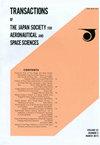Safety Analysis of Reduced Route Spacing for RNP 2 under Radar Environment
IF 0.7
4区 工程技术
Q4 ENGINEERING, AEROSPACE
Transactions of the Japan Society for Aeronautical and Space Sciences
Pub Date : 2021-01-01
DOI:10.2322/TJSASS.64.165
引用次数: 0
Abstract
This paper conducts a safety assessment for reduced route spacing for RNP 2 aircraft under a radar environment. Although the criteria for 15 NM separation standards exist, past safety assessment did not consider the surveillance environment. This consideration may reduce the possible route spacing. Here, to account for the surveillance environment, the recently developed ASEPS model is applied. Since this model was intended for deployment on oceanic route systems, the model parameters are modified appropriately while keeping the consistency of the past safety analysis and data analysis. In particular, the parameter of occupancy is set based on one-year flight data in Japanese airspace, and the calculation of action time to resolve the conflict is modified to estimate the collision probability more accurately. The results show that 8 NM route spacing satisfies the safety criteria.雷达环境下RNP - 2减小路由间距的安全性分析
本文对RNP - 2飞机在雷达环境下减小航路间距的安全性进行了评估。虽然存在15 NM分离标准的标准,但过去的安全评价没有考虑监测环境。这种考虑可以减少可能的路由间隔。在这里,为了考虑监视环境,应用了最近开发的ASEPS模型。由于该模型是面向远洋航线系统部署的,在保持以往安全分析与数据分析的一致性的前提下,对模型参数进行了适当的修改。其中,占用参数的设置基于日本空域一年的飞行数据,并对解决冲突的行动时间的计算进行了修改,使碰撞概率的估计更加准确。结果表明,8 NM的路由间距满足安全标准。
本文章由计算机程序翻译,如有差异,请以英文原文为准。
求助全文
约1分钟内获得全文
求助全文
来源期刊
CiteScore
1.80
自引率
0.00%
发文量
18
审稿时长
>12 weeks
期刊介绍:
Information not localized

 求助内容:
求助内容: 应助结果提醒方式:
应助结果提醒方式:


